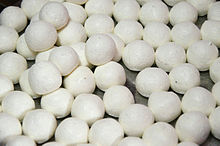 Chhena formed into balls to make rosogolla | |||||||
| Type | Cheese | ||||||
|---|---|---|---|---|---|---|---|
| Place of origin | Indian subcontinent | ||||||
| Main ingredients | Milk | ||||||
| 719 calories kcal | |||||||
| |||||||
Chhena (Hindustani: [ˈtʃʰeːna]) or chhana (Bengali: [tʃʰana]) is a kind of acid-set cheese originating in the Indian subcontinent that is made from water buffalo[1][2] or cow[2] milk by adding food acids such as lemon juice and calcium lactate instead of rennet and straining out the whey.[3]
Chhena is pressed and may be further processed to make paneer, a form of farmer cheese, or formed into balls to make desserts such as khira sagara, chhena kheeri, rasabali and ras malai, as well as sweets from the Indian subcontinent (mitha or Misti or mithai) such as chhena jalebi, chhena gaja, chhena poda, pantua, rosogolla, and sandesh. For the sweets, mostly cow milk chhena is used.
Chhena is produced in Bangladesh and eastern India, and it is generally made from cow or buffalo milk. In India, it is a legal requirement for Chhena to have no more than 70% of moisture content, and 50% of milk fat in dry material[4] The production of chhena in India was estimated to be 200,000 tonnes annually in 2009. Production is highest in the state of Uttar Pradesh, while consumption is highest in the state of West Bengal.[5]
Sahu and Das[6] conducted a study of milk consumption in India and found that 6% of milk produced in India is used in the chhena production process. It is closely related to paneer cheese as they both share a similar production process, but it is kneaded when it is still warm in the manufacturing process. The result is a cheese with a 'smooth, whipped-cream consistency', unlike paneer, which is firm.[7]
- ^ Dalby, A 2009, Cheese: A Global History, Reaktion Books, p. 73, ISBN 9781861897053
- ^ a b Kapoor, S & Kapoor, A 2006, Sanjeev Kapoor's No-oil Vegetarian Cooking, Popular Prakashan, p. 118, ISBN 9788179912928
- ^ Amitraj, K, Khamrui, K, Devaraja, HC, & Mandal, S 2016, 'Optimisation of ingredients for a low-fat, Chhana-based dairy spread using response surface methodology' International Journal of Dairy Technology, vol. 69, no. 3, p. 393
- ^ The Technology of traditional milk products in developing countries. Rome: Food and Agriculture Organization of the United Nations. 1990. ISBN 9251028990.
- ^ William, S & Aoyagi, A 2010, History of Soybeans and Soyfoods in South Asia / Indian Subcontinent (1656–2010): Extensively Annotated Bibliography and Sourcebook, Soyinfo Center. p. 1035. ISBN 978-1-928914-31-0.
- ^ Sahu and Das (as cited in Kumar, J & Gupta, V. K. & Kumar, S & Kumar, S 2015, 'Effect of coagulants on the quality of chhana and rasogolla obtained from admixture of buffalo milk and butter milk, Journal of Food Science and Technology, vol. 52, no. 3, p. 1736)
- ^ Carrol, R 2018, Home Cheese Making, 4th Edition: From Fresh and Soft to Firm, Blue, Goat's Milk, and More; Recipes for 100 Favorite Cheeses, Storey Publishing, North Adams, MA, p. 87